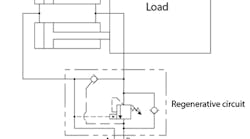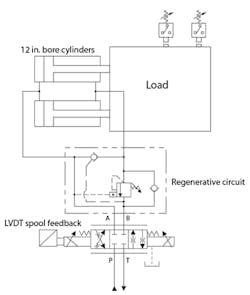A steel mill had a roll changer circuit consisting of two 12-in. bore, 8-in. rod, 96-in. stroke cylinders. These cylinders were mounted to a hinged deck plate that had another cylinder lifting and lowering it. To change a roll, the deck plate would raise to lift the two 12 in. bore cylinders. These cylinders would extend, pushing a worn roll out the other side of the mill. A crane would remove it and place another new roll in its place. The two 12-in. bore cylinders would then retract, pulling the roll stand into position.
A couple of improvements were added over the years to the same hydraulic power unit that supplied power to the two cylinders. During certain sequences, the additional oil needed for the improvements would lower the oil level in the reservoir to the point that pump-motors mounted on top would start to aerate. Maintenance needed to check the unit every day to make sure the oil level was adequate.
They found that during the roll change operation, the pumps seemed to aerate more frequently. One engineer had the idea to convert the two 12-in. bore cylinders to a regenerative circuit (see illustration) to reduce the oil volume drawn from the reservoir.
The existing circuit was controlled by a pilot-operated proportional valve that had position feedback on its main spool, but not on the pilot spool. The 12-in. bore cylinders used proximity switches to signal their position. The proportional valve was used to control the maximum speed, as well as acceleration and deceleration in both directions.
The circuit was revised to add the regen circuit shown on the hydraulic circuit. Manually cycling the new circuit showed no evidence of aerated fluid. Once ready, operators switched over to the automatic cycling, which was controlled by a PLC. With no heavy roll on the changer sled, they initiated an auto cycle. The cylinders extended with such a high velocity that they broke all their mounting bolts when they bottomed out, damaging the roll changer system.
The mechanical engineer couldn’t figure out why the system crashed. He had feedback on the valve spool, proximity switches were still functioning in their original locations, and other than the regen circuit, no other changes were made. The good part was it solved the low oil level aeration problem by leaving 59 gal of oil in the tank when using this system.
Based on the information given, what is the source of the problem?
Robert J. Sheaf Jr., is the founder of Certified Fluid Consultants (CFC) and President of CFC-Solar Inc. CFC-Solar provides technical training, consulting, and field services to any industry using fluid power technology. Visit www.cfc-solar.com for more information.
Mobile Equipment Training Challenges
Individuals that work on mobile equipment often require hydraulic and electrical knowledge beyond that necessary for maintaining equipment in fixed factory settings.
Industries such as energy, mining, construction, rail, waste management, agriculture, and oil and gas are loaded with mobile equipment. If you are faced with finding professional training for your fleet or unique mobile equipment, CFC Solar may be able to help. CFC-Solar is one of the most respected names in the mobile industrial training market with a history of developing training programs that teach individuals how to maintain today’s technically advanced mobile equipment. In addition to product specific training, CFC-Solar has standard training classes developed for the mobile industry that include:
• Level 1 Mobile Hydraulics – In Depth Fundamentals
• Level 2 Mobile Hydraulics – Advanced Maintenance
• Level 3 Mobile Hydraulics – Design and Sizing
• Troubleshooting Mobile Systems using Schematics
• Hydrostatic Closed Loop Systems
• Level 1 Mobile Electrical – Fundamentals
• Level 2 Mobile Electrical – Multiplex Systems
CFC-Solar is also one of the primary training firms in the world that provide Fluid Power Society Mobile Hydraulic Certification. For more information on our services, contact [email protected] or visit www.cfc-solar.com.
Find the solution
Think you know the answer? We’ll post this problem at fluidpower
talk.blogspot.com, and you can submit solutions there, or e-mail [email protected] with your solutions for a chance at a $50 gift card — we will randomly select a winner from all correct answers.
The correct answer will be printed on Jan. 3 at fluidpowertalk.blogspot.com and will be published in the next edition of “Troubleshooting Challenge.”
Congratulations to Howard Hurley, owner of Alacarte Engineering, LLC, Indianapolis, for providing the only correct answer to November’s problem. He won a $50 gift card.
Solution to a steel mill problem
Last month’s issue highlighted problems at a steel mill. After an update, the mill was seeing bumps and jolts during positioning of polishing heads. Replacing a proportional valve did not help. And an electrical engineer found that the electrical signal to the valve was clean and consistent in both increasing and decreasing modes.
To solve the problem, the maintenance department called in an outside hydraulic service shop for help. Dan Turner, of Turner Hydraulics, Carlisle Pa., examined the control and hydraulic system and felt the problem was probably the deadband of the proportional pressure and relieving valve. When the spool is controlling pressure, it acts as a modulating flow control. However, when it needs to reduce the flow faster than the built-in bleed off, the spool moves to completely block off the supply and open the outlet to the relieving port.
This type of pressure relieving valve normally has a spool with the same deadband characteristics as a standard directional valve spool. Turner found the valve to be a Sun Hydraulics PRDP type and confirmed this deadband construction. (Sun calls it their closed-center version.) He also found that Sun Hydraulics makes a PRDL model, what they call an open-transition version that has a more dynamic and bumpless transition between reducing and relieving modes. It also fits in the same cavity as the original valve.
The mill installed the new PRDL valve, which solved the problem.



